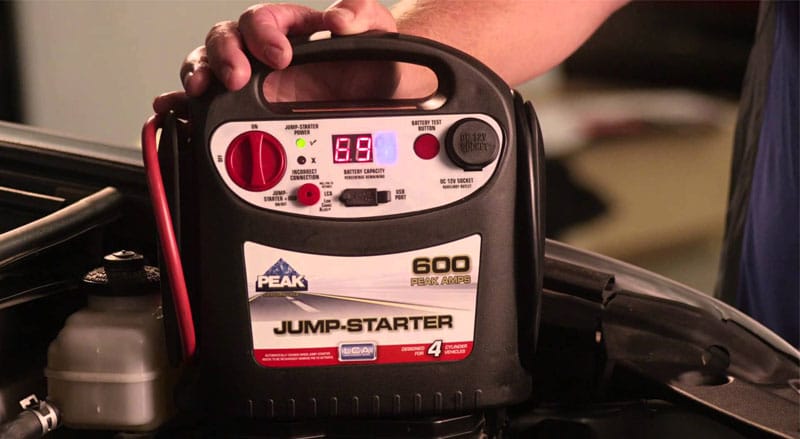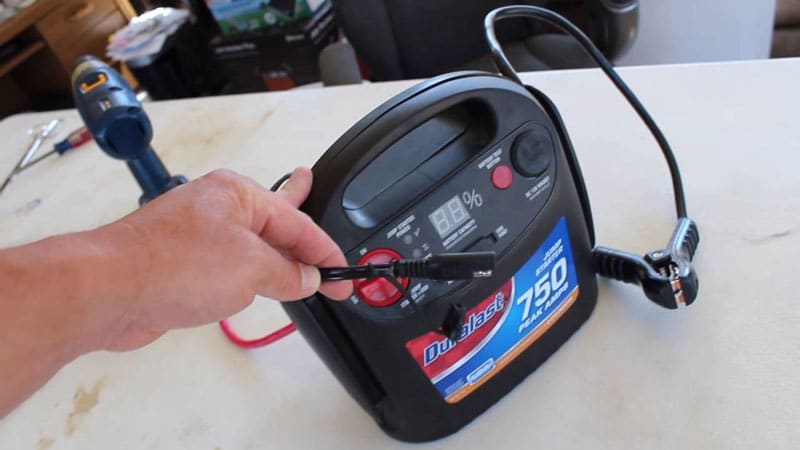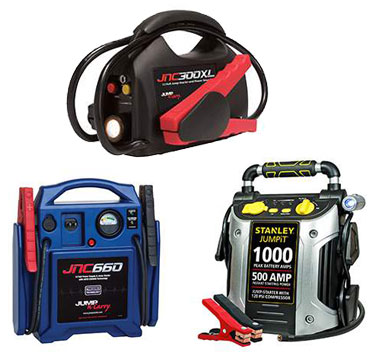

If you know how to charge a battery jump starter — you’re always ready to deal quickly and efficiently with a dead automotive power cell.
Jump starters are a great accessory for people who often have issues with their car batteries.
These units are affordable, efficient, and most importantly — easy to use. A lot of potential users give up on utilizing these units because they aren’t informed or experienced. There is no need to worry too much about the complexity of these machines because most of them are user-friendly and effortless to get the hang of. However, there are a few things you can do to improve your overall charging experience. While a vast majority of these accessories come with a user manual included, the manufacturers sometimes overlook some important facts or fail to mention important procedures in their manuals. It’s not that big of a deal if you’ve already used a jump starter before, but if you’re a complete beginner, the lack of crucial information can lead to some nasty consequences due to improper handling. This is your complete guide to ensuring your jump starter is always primed and safe for use.
Before I get down to the details of how to charge a portable jump starter — it’s worthwhile briefly considering what these machines actually do.
It’s important to differentiate starters from battery chargers — because they aren’t the same thing, by any means. Jump starters are units that deliver a great amount of power instantly to kick-start a dead or weak car battery.
On the other hand, battery chargers are designed to recharge a battery with a continuous flow of current which can take up to several hours. Therefore, the difference is pretty obvious – one is for kick-starting, whereas the other is for recharging.
Contrary to popular belief, jump starters can be used for charging various gadgets and act as a backup battery. For example, if you have a smartphone and you forget to recharge it before going on a trip, most modern jump starters offer a pretty simple solution. The I/O on most of these units includes a USB, micro USB, and other frequently used ports.
In other words, you can plug a smart device into the jump starter and use it as a power bank before finding a better solution or an electric outlet. It can come in handy, especially if you’re often on the road without easy access to electricity.
Today’s modern tech is increasingly cordless. While excellent for convenience and portability — it also requires a little discipline to ensure these machines are always fully charged.
How often have you reached for your torch during an electric outage, or pulled out your drill/driver to start a new woodwork project, only to discover they’re dead? Simply because you forgot to recharge.
That’s why understanding how to charge a jumper box is essential for the motor owner — not just meaning your unit is always primed and ready for use, but also getting you out of tricky situations.
If a dead cell prevents you from starting your car, it could mean missing a crucial doctor appointment, failing to get to work, or being unable to assist in family emergencies.
Don’t allow this to happen! Make sure you know how to charge a jump box!
So. down to business — how do you charge a jump starter? There are several methods for charging a starter. It all comes down to convenience, your circumstances, and what you personally prefer to use.
This method is probably the most used of them all, as it is one of the simplest. If you have access to an electric outlet, all you have to do is plug in the unit and wait for it to finish the charging cycle — typically via a standard USB cable and a two-pin plug adaptor. Most modern jump starters come with some sort of indicator that’s designed to inform you of the current level of both the unit’s battery as well as the car’s battery. In this case, the one you should refer to is the unit’s battery level. Most people advise charging it up to 100% every time, but it’s not a mandatory factor by any means. Unlike old nickel-cadmium cells — new lithium-ion batteries don’t suffer from degradation through under-charging, draining, and recharging. In other words, it will perform similarly with 20% less charge as long as it has enough output power to jumpstart a particular battery — with no damage to your power pack. As you can tell, this process is similar to plugging in your everyday smart gadget into a wall and waiting for it to recharge.

Every vehicle that isn’t a serious old-timer features a 12-volt power outlet — in fact, even some cars over thirty years old still have a cigarette lighter integrated somewhere on the board.
A vast majority of jump starter models sold nowadays come with a charging adapter included. It’s a great thing because it lets you utilize your unit without worrying about finding an electric outlet in the middle of nowhere — although the charging time will be considerably slower than using a household power socket.
However, there is an inherent flaw in charging a plug in jump starter with your car’s 12-volt outlet.
If you need your jumper in an emergency because your car battery is dead — there’s little point plugging it into your motor’s electrical socket. There’s no juice left in the car to replenish it.
Therefore, this method only works for:
One of the most frequently asked questions I receive here at Tool Nerds Towers is — can a jump starter charge a battery?
And unfortunately, the answer is no, you can’t start and charge your car battery with a jump starter — you need two different pieces of kit.
A jumper is designed as a short-term solution — delivering a high-amp energy burst to kick your dead motor cell into life. You then either need to allow the battery to charge by driving (powered by the alternator) or by using a standalone battery charger.
A battery charger cannot jump start — but it can give new life to dead batteries. Connected to a mains outlet, it delivers a slow trickle of energy to your cell to bring it back to full juice — which can take 10-24 hours.
Now, even though these units operate at very low voltages, that doesn’t mean they are harmless. In fact, whenever you’re dealing with electricity, especially the high amps knocked out by jumpers — there is always a chance for something to go horribly wrong and cause severe consequences.
The biggest cause of jump starter-related accidents is the user’s fault. A vast majority of units have different safety mechanisms that are responsible for preventing any accidental shocks and overcharging issues.
However, some inexperienced users bypass these mechanisms one way or another — thus exposing themselves to potential danger. It’s important to comprehend the included risks so that you can decrease the margin to a bare minimum.
Here are my five top tips for the safe use of a jump starter:
There are dozens of different jump starters on the market. You can find anything from a massive 6000-amp starter for larger cars and trucks to a small and compact 500-amp suitable for modest motors and motorbikes.
Generally speaking, the larger your vehicle’s engine, the higher the amps required from your jump starter.
Furthermore, consider what additional functions you want your starter to perform. Some models do nothing apart from jump vehicles. Others include USB ports to power your smart tech, LED lamp emergency lights, and in-built tire inflators.
The key is in finding the one that suits your needs the most. In other words, if you’re frequently on the road and away from home, make sure you can still utilize the starter without access to, for example, an electric outlet.
Needless to say, if you live in an area that doesn’t get too much sunlight throughout the year – don’t invest in solar chargers. In case you need a particularly powerful unit, make sure to check the peak amperage and compare it to consistent flow to get an idea of how efficient it actually is.

You now have all the knowledge you need to charge a jump starter! As you can tell, the process is pretty simple, yet it does require your attention and focus. As I said, every time you deal with electricity, there is a chance for something to go wrong. Even though those chances are little to none, it’s still important to remain cautious and aware at all times. In my opinion, every car owner should own at least one jump starter, especially if they are experiencing battery problems frequently. Ensuring your machine is always primed for action will mean dead batteries will no longer make you late for work, miss that must-attend social event, or fail to visit your mother-in-law! Whether using an AC power outlet, your vehicle’s 12-volt adaptor, or environmentally-friendly solar panels, you have no excuse for an unreplenished jumper — wherever you’re at home or out on the road. I sincerely hope you enjoyed my guide to charging your jumper! If you have a buddy you believe would also benefit from discovering how to charge a battery jump starter — please feel free to share!
A: Essentially, a jump starter is little more than a power bank — just with higher peak amps. Therefore, even if you lack the manufacturer’s charger, you can replenish it with a standard USB cable — powered by the mains, solar panels, or an in-car 12-volt outlet.
A: A 600-amp jump starter can be recharged by connecting to a household power socket. Typically, it will take around eight hours to fully replenish — depending on the mAh rating of the cell.
A: One of the most commonly asked questions by jumping newbies is — does a jump starter charge the battery? And, the answer is no! A jump starter delivers a rapid, high-amp boost to your dead car battery — allowing you to start the ignition. But, to recharge your motor’s 12-volt cell, you need a battery charger.
A: Car battery chargers require connection to an AC outlet to deliver energy to a dead car battery. While you can charge the in-built cell of a jumper, battery chargers cannot hold juice themselves.
A: 1. Ensure the battery charger is switched off. 2. Attach the positive clamp on the charger to the positive terminal of your battery. 3. Attach the negative clamp on the charger to the negative terminal of your battery. 4. Switch on the charger. 5. Set the timer for the period recommended by the manufacturer for your battery type. 6. Wait until the charger shows your battery as being fully charged.
A: If you want a conclusive answer to how long does it take to charge a jump starter — you may be disappointed! The truth is it depends on the make, model, design, and mAh rating of your jumper. The process, when connected to an AC outlet, can take anywhere from three to 24 hours.
A: Yes! Most jump starters arrive with some power in the cell. However, in most circumstances, the manufacturer will recommend you fully charge the unit before first use.
A: Yes, you can. However, you have to be prepared to make some compromises. The more features you want, the bigger the price — it’s as simple as that. On the other hand, if you’re not looking for auxiliary capabilities, don’t worry about the price, as it’s usually acceptable and affordable. Check out our best jump starter picks.
A: While it’s not a necessity, it’s definitely recommended. A jump starter can perform well even with 50% of battery left, but it won’t deliver as many kicks as it would with a higher percentage. Additionally, always read the manufacturer’s instructions on how to charge a battery jump starter — as it may indicate the number of charges available from an under-replenished machine.